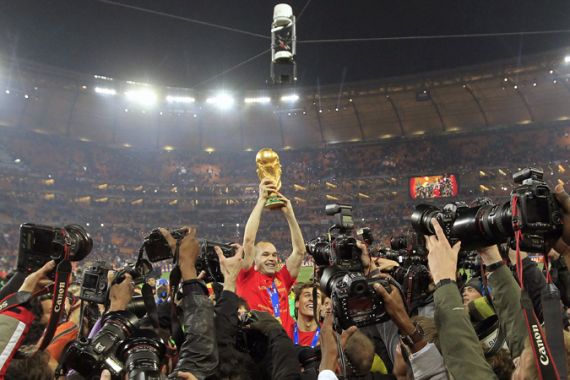Has football finally cracked the US market?
Euro 2012 broke US TV records, but Al Jazeera’s Sohail Malik asks if football can rival the big boys of American sports.

As Euro 2012 set a new television record for the tournament’s viewership stateside, it appears the perfect time for an English football club to switch its attention to the U.S.
Owned by American Malcolm Glazer, Manchester United have done just that announcing on Tuesday plans to raise $100 million in a U.S. initial public offering.
Keep reading
list of 4 items‘Disgrace’: Ten Hag slams criticism over Man United’s FA Cup semifinal win
Inter win heated Milan derby to seal 20th Siere A title
Bellingham’s late El Clasico winner leaves Madrid with one hand on La Liga
The Euros have proved that the game called football in Europe, and soccer is the U.S, is growing as a sport and brand.
Each game drew an average audience of 1.2 million viewers – a 61 per cent hike in viewers from the last tournament in 2008.
This follows a string of impressive audience figures for international football competitions in recent years. The final of the 2011 Women’s World Cup, in which the US lost to Japan, drew an average audience of 13.5 million – making it ESPN’s most watched football match in history. The 2010 World Cup raked in an average 3.3 million viewers per game, a 41 per cent increase in viewers from 2006 making it the most ever watched World Cup in the US on English language television.
Viewership for international events is on the rise, but whether that means football will soon challenge more popular games like baseball, basketball and American football is debatable. The answer depends on how one measures progress. If audience stats are the barometer then football is not doing badly.
The biggest game in football, the World Cup final, cannot compete with NFL’s Super Bowl – which had 111.3 million viewers watching the New York Giants and the New England Patriots fighting it out in February. But the 24.3 million viewers of the 2010 World Cup final at Soccer City in Johannesburg does compare favourably to showpiece events of other American sports.
The deciding Game 7 of MLB’s World Series in 2011, eventually won by the St Louis Cardinals, pulled in 25.4 million people – approximately one million more than the World Cup final. However football’s showpiece beat the deciding game of the recently concluded NBA finals, between Miami Heat and Oklahoma City Thunder, and the most watched game of NHL’s Stanley Cup, between eventual winners Los Angeles Kings and New Jersey Devils – which were seen by 18.5 and 4.93 million viewers respectively.
But the World Cup happens every four years and its novelty might explain its competitive ratings. The other events mentioned are yearly and feature domestic teams that represent cities and states – while the World Cup has national appeal as Team USA competes in it.
Therefore some might argue that viewership for the country’s very own competition, Major League Soccer, might be a better yardstick. The MLS Cup Final in 2011 between Houston Dynamo and Los Angeles Galaxy barely managed to get more than a million viewers – a dent on any argument that an American football revolution is coming.
Home-grown success
Optimists may point to improving attendance figures however.
MLS is now the third best attended spectator sport in the US – ahead of the NBA and NHL. Last season the average attendance for the 18 clubs increased by 7.2 per cent to 17,872 spectators per game.
This has been viewed as major achievement within the country’s footballing brass, and American success at international level might be a contributing factor.
The men reached the World Cup quarter final in 2002, the second round in 2010 and were runners-up in the 2009 Confederations Cup. The women have excelled further and are ranked number one in the world by world football’s governing body FIFA. They are former world champions and will be seeking their fourth gold medal in a few weeks at the London Olympics.
Furthermore, football interest in the US has grown by 25 per cent between 2006 and 2011 according to sports research group SPORT+MARKT. In a study carried out last November they found that 25 per cent of US citizens, aged 16 to 69, are interested in football, an increase from the 2006 figure of 20 per cent.
The actions by television networks suggest they recognise this growth.
International broadcasters ESPN believe that the American audience understand the game and went into their coverage of the Euro 2012 final with that attitude.
Ahead of the game ESPN’s British commentator Ian Darke told the Associated Press “it really would be an insult if somebody like me and Macca [co-commentator Steve McManaman] came on trying to sort of teach people to suck eggs about the game.”
He continued ”I think they tune into it because they know it and they love it – or most of them do.”
Al Jazeera itself have also realised the appetite for football in the states, and will launch their network for sports channels beIN Sport in the States this summer. The Qatar-based-network plans to show league football from Spain, France and Italy as well as the Copa America and South American qualifying matches for the 2014 World Cup.
So with the major networks complimenting increased viewership – combined with national team success and the surpassing of major sports in terms of attendance – football might just one day challenge the biggest sports.
Who knows, one day Americans might join the rest of world in calling the game football.